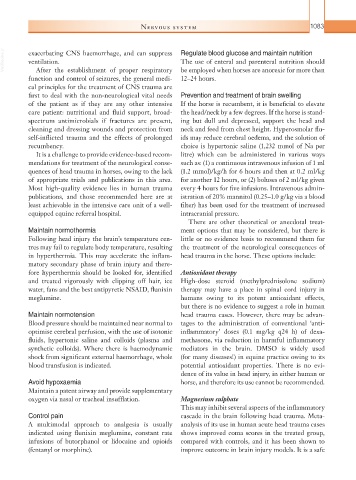Page 1108 - Equine Clinical Medicine, Surgery and Reproduction, 2nd Edition
P. 1108
Nervous system 1083
VetBooks.ir exacerbating CNS haemorrhage, and can suppress Regulate blood glucose and maintain nutrition
The use of enteral and parenteral nutrition should
ventilation.
After the establishment of proper respiratory
function and control of seizures, the general medi- be employed when horses are anorexic for more than
12–24 hours.
cal principles for the treatment of CNS trauma are
first to deal with the non-neurological vital needs Prevention and treatment of brain swelling
of the patient as if they are any other intensive If the horse is recumbent, it is beneficial to elevate
care patient: nutritional and fluid support, broad- the head/neck by a few degrees. If the horse is stand-
spectrum antimicrobials if fractures are present, ing but dull and depressed, support the head and
cleaning and dressing wounds and protection from neck and feed from chest height. Hyperosmolar flu-
self-inflicted trauma and the effects of prolonged ids may reduce cerebral oedema, and the solution of
recumbency. choice is hypertonic saline (1,232 mmol of Na per
It is a challenge to provide evidence-based recom- litre) which can be administered in various ways
mendations for treatment of the neurological conse- such as: (1) a continuous intravenous infusion of 1 ml
quences of head trauma in horses, owing to the lack (1.2 mmol)/kg/h for 6 hours and then at 0.2 ml/kg
of appropriate trials and publications in this area. for another 12 hours, or (2) boluses of 2 ml/kg given
Most high-quality evidence lies in human trauma every 4 hours for five infusions. Intravenous admin-
publications, and those recommended here are at istration of 20% mannitol (0.25–1.0 g/kg via a blood
least achievable in the intensive care unit of a well- filter) has been used for the treatment of increased
equipped equine referral hospital. intracranial pressure.
There are other theoretical or anecdotal treat-
Maintain normothermia ment options that may be considered, but there is
Following head injury the brain’s temperature cen- little or no evidence basis to recommend them for
tres may fail to regulate body temperature, resulting the treatment of the neurological consequences of
in hyperthermia. This may accelerate the inflam- head trauma in the horse. These options include:
matory secondary phase of brain injury and there-
fore hyperthermia should be looked for, identified Antioxidant therapy
and treated vigorously with clipping off hair, ice High-dose steroid (methylprednisolone sodium)
water, fans and the best antipyretic NSAID, flunixin therapy may have a place in spinal cord injury in
meglumine. humans owing to its potent antioxidant effects,
but there is no evidence to suggest a role in human
Maintain normotension head trauma cases. However, there may be advan-
Blood pressure should be maintained near normal to tages to the administration of conventional ‘anti-
optimise cerebral perfusion, with the use of isotonic inflammatory’ doses (0.1 mg/kg q24 h) of dexa-
fluids, hypertonic saline and colloids (plasma and methasone, via reduction in harmful inflammatory
synthetic colloids). Where there is haemodynamic mediators in the brain. DMSO is widely used
shock from significant external haemorrhage, whole (for many diseases!) in equine practice owing to its
blood transfusion is indicated. potential antioxidant properties. There is no evi-
dence of its value in head injury, in either human or
Avoid hypoxaemia horse, and therefore its use cannot be recommended.
Maintain a patent airway and provide supplementary
oxygen via nasal or tracheal insufflation. Magnesium sulphate
This may inhibit several aspects of the inflammatory
Control pain cascade in the brain following head trauma. Meta-
A multimodal approach to analgesia is usually analysis of its use in human acute head trauma cases
indicated using flunixin meglumine, constant rate shows improved coma scores in the treated group,
infusions of butorphanol or lidocaine and opioids compared with controls, and it has been shown to
(fentanyl or morphine). improve outcome in brain injury models. It is a safe

